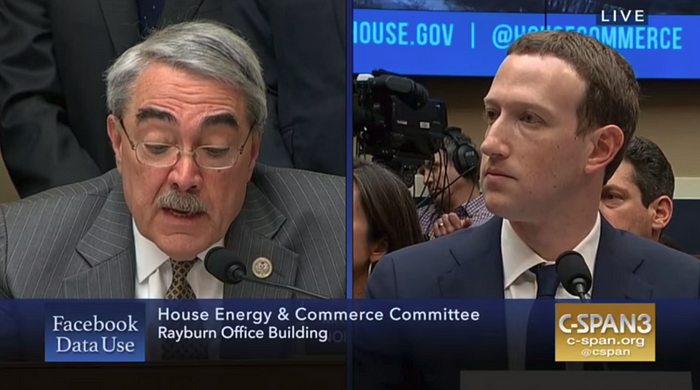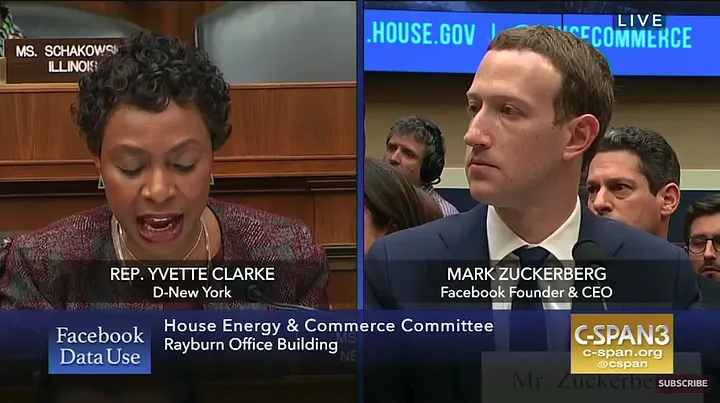As Mark Zuckerberg testified in front of Congress, the world was transfixed, listening for insights about how our personal information has been collected, shared, and sold, and for assurances that immediate steps will be taken to ensure our privacy will be protected by tech giants.
But another equally important narrative surfaced in the questioning of Zuckerberg, one that has received much less attention: Why are women and people of color just a tiny proportion of Facebook’s workforce and leadership? Why have the numbers barely budged in 4 years? And perhaps most importantly, what is the CEO of Facebook willing to do to change these numbers?
(If you are wondering why a line of questioning about Facebook’s lack of diversity belongs in Congressional testimony about data privacy, Cambridge Analytica, and Russian hacking of the 2016 election, read more here and here).
Rep. Yvette Clarke (D-New York) asked whether Facebook’s lack of diversity may have impacted the company’s response to propaganda targeting people of color and stoking racial tensions, saying, “I’m concerned that there are not eyes that are culturally competent looking at these things and being able to see how this would impact civil society,” she said. “If everyone within the organization is monolithic, then you can miss these things very easily.”
Research continues to confirm the business case for diversity, by demonstrating the positive correlation between diversity revenue, profitability, innovation, and employee satisfaction. And Rep. Clarke is right — numerous examples demonstrate how the lack of diversity on teams can negatively affect product ideation, algorithm development, and marketing and enable discrimination and harassment (See examples from Google, Snapchat, AirBnb, NextDoor, Microsoft, and Facebook). So, why aren’t we seeing any real progress on tech’s diversity?

Companies are spending hundreds of millions of dollars each year on initiatives to increase diversity, yet their diversity numbers have barely budged. In Silicon Valley, the percentage of Black and Latinx tech professionals has actually decreased.
Rep. Butterfield (D-NC) cited Facebook’s lack of diversity in its C-Suite and miniscule progress on racial diversity, and asked Zuckerberg for a firm commitment to hosting a meeting of CEO’s to make REAL change in tech.
“CEO leadership… on issues of diversity is the only way that the technology industry will change, so will you commit, sir, to convene a meeting of CEOs in your sector…to develop a strategy to increase diversity in the technology industry?” she asked.

“Congressman, I think that’s a good idea and we should follow up on it,” Zuckerberg said. “We care about this not just from the justice angle, but because we know that having diverse viewpoints is what will help us serve our community better, which is ultimately what we’re here to do.” A hollow response, lacking a strong and firm commitment.
When Rep. Butterfield asked about a commitment to publishing disaggregated retention data to provide transparency about workplace culture and turnover?
“I will discuss that with my team,” Zuckerberg said.
These vague statements are indicative of a larger problem we are seeing in tech. And Mark Zuckerberg is far from the only one to blame. Four years after the Silicon Valley giants began releasing their employee data, and reluctantly revealing the vast racial and gender disparities in their workforce, a great deal of attention has been paid to the lack of diversity in tech. Companies have spent a lot of time talking about the problem, making commitments, hiring D&I directors, implementing initiatives like unconscious bias training, and focusing on developing the pipeline (because they blame the pipeline for the lack of diversity rather than their unwelcoming cultures and biased practices). And unsurprisingly, little actual progress has been made.
Worse yet, a new study of tech employees by Atlassian reveals that “diversity fatigue” is setting in and despite the belief in the importance of diversity, individual and company actions towards increasing diversity are stalled (and in some cases declining).

Two findings from a study of 1,900 tech employees in the U.S. really stand out:
- In 2018, fewer companies are implementing programs to increase diversity and inclusion than in 2017. Less than 45% of tech employees work in companies that have a formal D&I program.
- In 2018, fewer tech employees are taking individual action to engage their leaders, learn about diversity and engage with diverse colleagues than in 2017.
These findings are consistent with our view that Silicon Valley has, for too long, viewed the problem of racial and gender disparities in tech in overly-simplistic ways and looked for easy fixes by applying window dressing to complex, large-scale problems. We have been caught up in arguments about whether the lack of diversity in tech is a pipeline problem OR a tech culture problem — each of which present a partial and incomplete framing of the problem. And without a correct framing of the problem, we see quick and easy one-off solutions being implemented, rather than the comprehensive, complicated, and long-term structural changes that are needed. The one-off solutions have been (surprise!) unsuccessful, creating the weariness and fatigue we are beginning to see across tech.

Instead, all the data show that a comprehensive and shared framework must be adopted across the ecosystem. The Leaky Tech Pipeline framework describes disparities in tech as the result of a complex set of interrelated and cumulative biases and barriers that occur across the tech ecosystem, from PreK-12 education through the workforce, entrepreneurship, and venture capital. We know that when comprehensive strategies are implemented, starting with a commitment from the CEO and including a multi-pronged strategy to improve recruitment, hiring, promotion, pay, culture, employee satisfaction and retention increases, and so does innovation and productivity. When local and state government officials, policymakers, educators, and private philanthropy work together make large, long-term investments in computer science education, more students of color and girls have the opportunity to enter into the computing pipeline. The exorbitant wealth of tech should be used to create systemic change, invest in education and workforce development, expand the pipeline, and break down barriers so women and people of color can enter and succeed in tech.
Armed with this framework and understanding, we can push for meaningful change. But how many tech CEO’s and venture capitalists are ready and willing to do the hard work? Do they actually want to implement long-term, comprehensive commitments to changing the demographics of the workforce, or are they simply content with a “trophy for participation”? While a comprehensive approach may be expensive, it certainly doesn’t cost more than the $16 billion annual pricetag of unwanted turnover due to being treated unfairly or the roughly $1.2 billion dollars tech giants have invested in diversity in the last 5 years.
The data from Atlassian’s study should be alarming and eye-opening: Not only are we not making progress, but fewer individuals and companies are committing to doing the hard work to drive this much-needed change.
Having a homogenous tech sector cannot be the acceptable norm. Tech leaders might not feel the palpable urgency in the same way that communities of color and other marginalized segments of our population do. As their profits continue to rise, Black-White and Latinx-White wealth gaps grow even wider. In tech’s wealth centers, like the SF Bay Area, tech employees (largely White, Asian, and male) are driving the economy, while gentrification, poverty, underemployment, a housing crisis, and homelessness are affecting everyone else. As new millionaires are created overnight (largely White, male millionaires), their technology is being used to widen gaps, increase discrimination and harassment, suppress voters, and undermine our democracy. While this wasn’t the original intent of the technology, it’s nevertheless a result of the shortsightedness of the tech leaders who allowed it to happen and remain comfortable with the status quo.
So yes, Mr. Zuckerberg, please do follow up with your team, and with your fellow CEO’s. You say that diversity is a business and social imperative, so here is your opportunity to use your platform and power to lead for positive change in tech.

